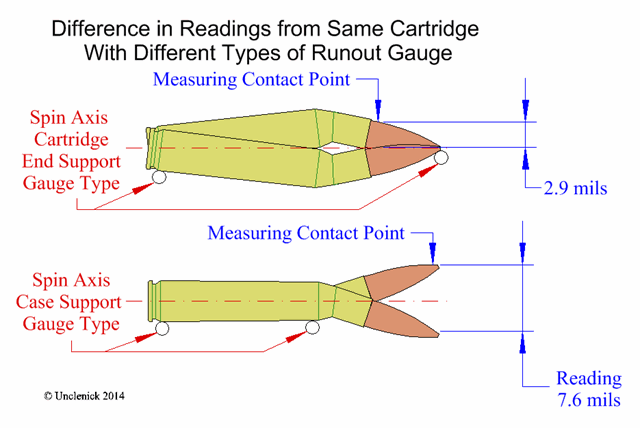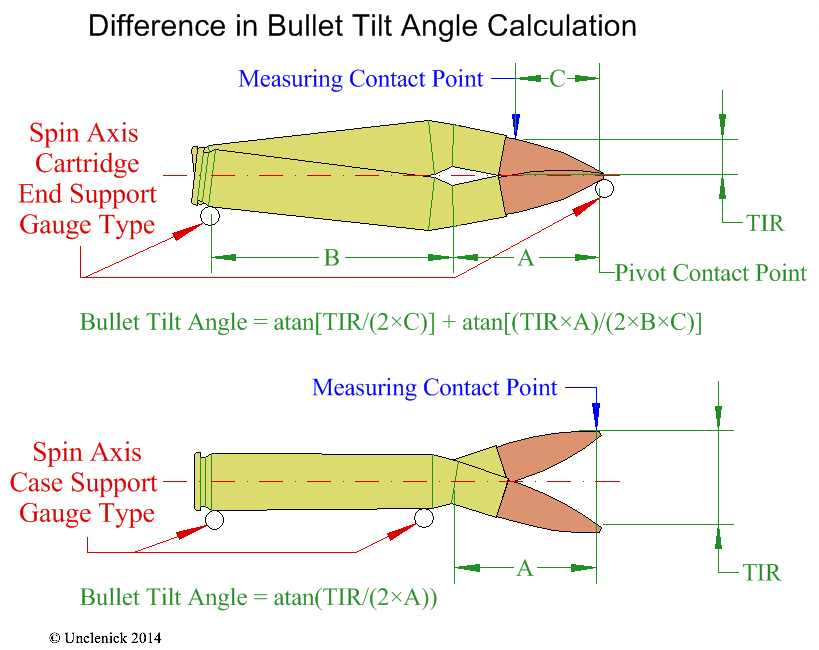Hooligan1,
Just to be clear, I wouldn't use both a case master and the concentricity gauge. I was merely referring to how the Case Master measures concentricity giving higher resolution for figuring the tilt angle. If you are at the point of deciding which to buy, the Case Master additionally will let you measure internal case wall runout, and that helps sort out the best cases for a critical precision applications.
If you looked at the video on the Lee Collet Die I linked to, you'll see the neck is where the tilt is rooted. It is, indeed, the expander that is responsible for neck tilt introduced during resizing. One also bends or bulges the neck during seating if you push the bullet in cocked at an angle. That is the reason the seating dies matter. Bullet tilt caused by cocked seating is already stressing the neck wall unevenly, so correcting it with the Hornady or Bersen tools may make it no worse. The NECO tool or the hole in the bench are just less likely to worsen this when applied to the neck rather than just to the bullet.
The above is something you have to test empirically in your rifle, as some chamber and bullet combinations are more sensitive to bullet tilt than others. That is, some chambers seem to straighten bullets during firing better than others do. You’ll just have to shoot to decide whether straightening and how that straightening is done affects your rifle’s precision. You also want to take a chronograph to the range and see whether straightening affects you velocity SD’s. If it makes them worse, then you are getting irregular bullet pull that is affecting start pressure adversely. Such rounds probably won’t do as well at long range.
One test I like to do is to select a dozen rounds that are very straight and a dozen that are badly tilted. I mark the high side of the tilt with a magic marker or a sharpie on the back of the case head. I shoot ten fouling shots into a practice group (that seems like a lot, but I’ve seen some guns take that long to settle and I want a baseline group size and velocity SD anyway). Next, I shoot the marked twelve cartridges onto one target, chambering them so the high spot mark is indexed 90° for each shot. That is, one shot each at 12:00, 3:00, 6:00, 9:00 in the chamber, and then back to 12:00 to start the next 4, etc., until all twelve are fired. I then clean the gun and fire ten more foulers to further establish my baseline means, and then the twelve straight rounds. If the gun is sensitive to tilt with the bullet as I’ve loaded it, the indexed group is biggest. Indeed, with a benchrest gun it will produce four distinct 3-shot groups forming a kind of four-leaf clover. If the cocked bullet seating affects bullet pull significantly, this group also has the highest velocity SD.
Assuming your chamber and load combination shows sensitivity to bullet tilt, you can repeat that experiment with straightened bullets and see what sort of group sizes and SD’s you get from them. Comparing them to the straight round group will reveal if your straightening method is adversely affecting anything or if it’s fixing them just fine.
In the case of the expander, you can remove it, but you will find your necks are narrower than they were when you used it. The standard die has to be able to resize the thinnest neck walls made. Most are not that thin, so running them into the neck of the die causes their ID's to be squeezed too narrow. That is what the expander corrects. If you get a neck too narrow, the bullet has to push that much harder on it during seating, so you tend to increase neck tilt and distortion introduced at that stage of the process.
There are a number of strategies to address this. One is to reduce friction between the neck and expander so the portion of the expanding force pulling on the neck during expansion is reduced. This can be done by lubricating inside necks, by going to a carbide expander, or better yet, to both.
Another is to size without the expander, then reinstall it and, using a good dose of inside neck lube, running the case up over the expander so the expansion happens pushing into the case. This seems to be less prone to neck tilt than pulling the case over the expander. Unlike a bullet, the expander doesn't tilt on its way in. Another approach is to use a mandrel with a tapered tip for the above action. That produces even less lateral force. Sinclair makes a die body that holds expander mandrels that can set the final ID in a case that has been sized without an expander. They are even available in carbide for still less friction, but I would use inside neck lube anyway.
Another possibility those using a standard seater die us to buy a Lyman M expander die. The M die originally was for cast bullet loading, but it helps start jacketed bullets straight into a case as well. It not only expands and flares, but puts a short step in the case neck below the flare that is a thousandth or two wider than the bullet. That step acts like a little cup you set the bullet into that holds it straight upright to enter the seater ram. This means the seater pushes the bullet straight down without tilt. For jacketed bullets you set the M die high enough so the step forms short of flaring. When you seat, you then want the seater die body set low enough that the crimp groove just irons the step out at the mouth for feed reliability, even if you aren't crimping. If you have a separate taper crimp die, that is best for this task.



